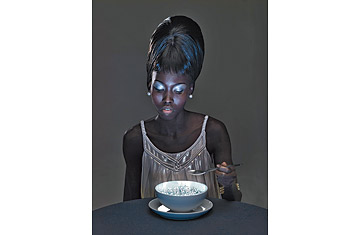
You've been cooking like an idiot. You press on meat and compare it with the flesh on your hand to guess how rare it is; you throw spaghetti at the wall to see if it's done; you add an amount of salt that looks pretty when it's in your palm. If people made medicine this way, we'd all be dead.
Home cooks are about to learn what Kraft Foods and McDonald's have known for more than 50 years: placing food over heat is science, not art. The resistance to food science (the phrase stinks of school cafeterias, Velveeta and those weird colored balls they sell at ball games as the dystopian "ice cream of the future") has grown stronger with the local, organic and slow-food movements. But resistance is futile. And misguided. "Maybe part of the fear is Soylent Green," says NYU chemistry professor Kent Kirshenbaum, who co-founded the Experimental Cuisine Collective, which explores scientific principles that can be applied to cooking — like finding a replacement for the powder from threatened orchid tubers that's used to make a stretchy Turkish ice cream called salep dondurma. "There's been some confusion about whether or not our approach toward taking a scientific understanding of foods has to do with artificial foods and the processing of foods." But Kirshenbaum is dedicated to fresh ingredients. You can have your organic vegetables and eat them as hydrocolloids too.
As fewer people actually do any cooking — because prepared dishes at supermarkets, meal-prep kitchens and restaurants will get even cheaper — the remaining brave cooks are going a little mad scientist. This paradigm shift won't be such a big deal in practice. Your oven is pretty much an advanced science gadget already, you use meat thermometers, and that measuring cup looks an awful lot like a beaker. You're just going to have to step it up a little: replace that liquid-measuring cup with a more accurate dry-weight scale; get a vacuum sealer like that FoodSaver gadget and a Crock-Pot that stays at a precise temperature so you can sous vide meat (which involves cooking it in a bag for a long time in a low-temperature water bath); learn how to use simple chemicals like agar-agar and xanthan gum (just better versions of gelatin and cornstarch, really); review a little high school chemistry. No big deal.
It's going to mean cooking a little more carefully, like you would bake. Which will be made easier through gadgetry. Speed ovens like the TurboChef circulate hot air at up to 60 m.p.h. (almost 100 km/h), making precise temperature changes so simple, you don't even know they're occurring. (A 31⁄2lb. [1 1/2 kg] chicken cooks in 14 min.) And induction cooktops are more than twice as energy efficient as gas burners, allowing for quicker temperature changes.
Sure, some cookbooks will need to be rewritten, but stuff is always getting updated online, so you won't even notice. "Transition temperatures for every protein in an egg or meat are pretty well known," says Harold McGee, author of On Food and Cooking: The Science and Lore of the Kitchen. "In industries, that information is used to optimize processes. That kind of information hasn't entered the home kitchen yet. There's a pretty big difference between heating an egg at 60 C and 61 C." Kraft Foods knows that, and soon you will too. Whether you want to or not.